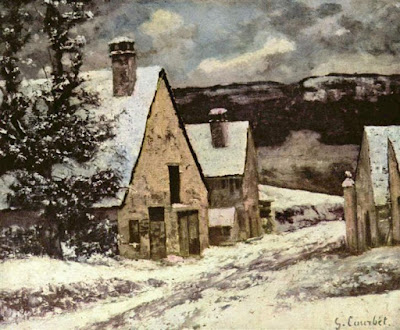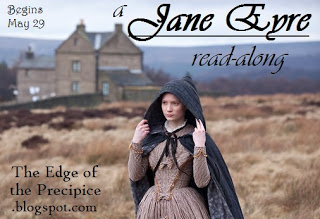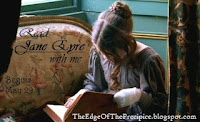And we’re off! The Edge of the Precipice’s Jane Eyre read-along is off to a great start. It’s been a good number of years since I read this work last, and it’s certainly one of my favourites. With a reasonably adequate background to the book, I’m looking forward to digging deeper into its pages. My last Charlotte Brontë read, Villette, was less than thrilling (in fact, I could hardly believe it was the same author), so it will be refreshing to revisit her masterpiece. So without further ado, let the reading begin!
In which we are introduced to Jane, who is a ward of Mrs. Reed who has three children, Eliza, John and Georgianna. Jane is treated as not much better than a servant and is tormented unceasingly the the three children of the house. Finally, persecuted beyond bearing when Master John Reed throws her book at her, cutting her head, Jane reacts with a vehemence, hurling insults at him. Of course, Jane gets punished for her behaviour, while John Reed is given only sympathy from his mother. Poor Jane is taken to the red-room and locked there.
Right away Brontë masterfully crafts the mood, describing a gloomy and melancholy setting, with “clouds so sombre, and a rain so penetrating …”, “chilly afternoons,” and “nipped fingers.” The reader is able to immediately get an inkling of the tone of the upcoming chapters.
We understand Jane’s isolation not only from descriptions of her situation, but from parallels to her physical surroundings. From the bleakness of the winter season, the leafless trees, the cold, unfriendly, biting wind and the slow interminable passing of the hours, we feel her rejection and her solitude just as Jane experiences it. Even her reading of Bewick’s ‘History of British Birds’ echos her aloneness, as she describes from it the “bleak shores” of far of countries, the desolate realms there and the remoteness. As we read of the physical isolation, we certainly get a strong sense of Jane’s social isolation.
By Jane shutting herself away on the window-seat using the red curtain, which is later called “scarlet drapery”, we are reminded of a scarlet woman, or in this case, a scarlet child, where the person is ostracized because their behaviour does not meet societal standards.
Quite interestingly, Jane also mentions listening to the novel, Pamela, or Virtue Rewarded, which is a story of a servant who marries her employer. A little foreshadowing here, perhaps?
 |
| Village Street in Winter (1865-70) Gustave Corbet source Wikiart |
Jane fights her jailors, Bessie, the nurse and Miss Abbott, before promising not to move if they do not tie her to the chair as they plan. Apparently she had never behaved so before, although Miss Abbott remarks that she’d always had it in her, which perhaps gives more illumination to Miss Abbott’s character than Jane Eyre’s. After painful reminders of her station as a “less than a servant” by Bessie, and threats with regard to the state of her soul by Miss Abbott, Jane is left alone. Now a rather Gothic twist is brought on by her fear of the ghost of Mr. Reed, who died in this red-room nine years ago. As she thinks about his death, she sees herself in the looking-glass, appearing small and impish, like a tiny phantom. As she stews on all the injustices that she has had to face from the family, she also recognizes that her own character is in some way responsible for her fate. As daylight fades from the room, her imagination takes her away, as she muses that if Mr. Reed were alive, he would take her part, and wishes his ghost would return to haunt his family and put things to right. Seeing a streak of light on the wall, she imagines a coming spirit and attempts to escape, making enough noise that her jailors come running, however Mrs. Reed appears and, in spite of Jane’s frantic condition, orders her back to the room, where she faints.
 |
| Young Girl with Long Hair (1942) Moise Kisling source Wikiart |
This was a curious chapter with much to ponder. We see it as a turning point: whereas before it appears that Jane’s resistance to her treatment was all mental, finally it becomes physical as Bessie remarks, “she never did so before.”
There is also descriptions of what is commendable in the Reed household, and what is unacceptable. It appears that vice, bad manners, and cruelty is lauded, whereas patient suffering, obedience and compassion is disparaged.
The Gothic imaginings of the ghost is a curious insertion, but it does serve to reinforce Jane’s predicament, her isolation, and sets up the scene with Mrs. Reed, further emphasizing the woman’s cold-hearted cruelty.
All these scenes enhance our pity for Jane, and our wish for her to escape her hardships. An excellent introduction!!
Note: I’m still wondering about the significance of the colour red in these chapters.




informative post… and it reminded me why i never reread it. i must be shrinking violet, or some sort of hot house flower… the pain of the novel was more than very unpleasant and i remember being really glad when i finished it… sorry, that's probably not what you wanted to hear. i have to say i liked "Villette" a lot more…
Jane Eyre is one of my all time favorite books. I can't count how many times I've read it.
One thing that always pierced me was Eyre's loneliness. She was completely alone at the Reed household, mostly alone later. But at the same time, she develops a steely independence that is already evident in this small rebellion against her oppressors.
It seems unthinkable that people could be so cruel to another child, especially one they're related to, but maybe some people were capable of it because their sense of "class consciousness" was so strong (Jane's father married beneath him).
I recently read Jane Eyre and the early chapters when she's younger were my favorites despite her torment. I liked the Gothic atmosphere and how fiery she is.
I recently read Jane Eyre and the early chapters when she's younger were my favorites despite her torment. I liked the Gothic atmosphere and how fiery she is.
I just started…yes I am still playing catch up! But I finished chapter 2 and I agree with you that at the very onset the good and the bad of the Reed household is very clearly illustrated. I know Bessie is a minor character but I really really liked her portrayal. Bronte very smartly illustrates the plight of a good person, forced to work as a hired help in a household. While she gives all the unecessary due to the Reeds and never defies them, there is a kindly spirit in her that wants to help Jane and make her life easier, even if it means trying to make Jane accept her life as a third grade dependent. I always find the second chapter very gothic, something that should belong to Emily Bronte's work rather than Charlotte's, but here I may be partial again; but the images created by Charlotte I believe are far more real and therefore far more intimidating. The fear of a 9 year old is palpable and can be felt through the chapter! Ok….my mini review is done! 🙂
I love Jane Eyre and re-read it recently, or else I would be tempted to do the read-along. Mrs. Reed is so horrible to Jane and Jane's terror of the red room is so palpable. I love the way Charlotte sets the mood of the novel in these first few chapters and in the next couple at Jane's school as well.
Sorry to hear that you didn't enjoy Villette half so much–I had been meaning to read that one!
Not at all! I think we all can have different reactions to books depending on our circumstances and life experience.
I do agree that this novel explores painful situations, but what I like about it is that I think it shows how to struggle out of them and rise above them. To a certain extent we can control outward circumstances by how we view and behave toward them inwardly. Jane, with the help of her character, found contentment in the end even through life's bumps, whereas I didn't see the depth or convictions in Lucy's character to learn from her or to think she moved on to have any sort of inner peace, so for me, Villette was more bleak.
How long has it been since you read Jane Eyre?
I love this book more each time I read it. I think of how, even though there is a little drama to it, it conveys life and what one can experience in it in a very real way.
I agree. Jane allows her experiences to shape her character in a positive way. While she doesn't always make the best choices at certain moments, overall she learns from the incidents, and uses them to her benefit. I quite like her quiet, yet internally forceful character.
Why did you like the early chapters better than the later ones, Zezee? I really like her quiet fortitude; she is strong, but she's also very much a woman.
I haven't moved on to the next chapter yet, so I'm still wondering about this Gothic-ghost thing. I can only think it illustrates the complete lack of compassion of Mrs. Reed and firmly fixes our sympathy with Jane. But yes, it is curiously unusual.
Thanks for the mini-review! I love your comments because they get me thinking!
Yes, she does a wonderful job setting the mood, doesn't she, with everything from the physical setting to the character's moods.
Many people really like Villette, so give it a try. I like to get something positive out of a novel (even if it is something positive from something negative), but this one left me flat. And I was bugged —- Charlotte Brontë wrote it after a number of tragedies in her life and I believe her despair showed through in a melancholic treatment of the characters and even a tendency to play with the reader's emotions. I'd love to know what you think, when you get around to reading it. I'm looking for someone to boost my appreciation of it, but so far, it hasn't happened. 🙁
a very long time, in my collegiate years, probably; i remember tearing through it in a hurry to get finished because it was upsetting, so i most likely missed the points you were kind enough to mention, above, there… tx for the explication; i may conceivably try it again some day…
I think you're so right about Pamela foreshadowing Jane's own story. Even the subtitle there, Virtue Rewarded — Jane's got so much of that going on in her life, huh? Not at first, but eventually.
And I wonder if virtue was so important to her because she experienced so much vice at the Reeds. They were certainly examples of how not to be.
Quite possible!
Pingback: Jane Eyre by Charlotte Brontë - Classical CarouselClassical Carousel